30 Stories for Sjögren’s Awareness
April is Sjögren’s Awareness Month! Sjögren’s is one of the most prevalent autoimmune diseases, affecting an estimated 4 million Americans. In our #ThisIsSjögrens online campaign, we are featuring 30 real patients to show the diversity and impact of this complex disease.
Every day in April, we will highlight a different patient to create a better understanding of the disease. While the daily posts will each give one small glimpse into living with Sjögren’s, by the end of April, we hope these 30 posts will help others understand that the disease is serious, systemic and prevalent. In addition, this year, we will also feature an in-depth “patient to patient” story on Fridays that look at specific disease symptoms and share how patients are effectively coping with the disease and offer advice for others.
We encourage you to follow our campaign and remember that every day is an opportunity to start a conversation about Sjögren’s and how it affects you. Together, we will conquer the complexities of Sjögren's! If you'd like to share your story, please click the link at the bottom of this page.
April is Sjögren’s Awareness Month
Sjögren’s (“SHOW-grins”) is a systemic autoimmune disease that affects the entire body. Along with symptoms of extensive dryness, other serious complications include profound fatigue, chronic pain, major organ involvement, neuropathies, and lymphomas.
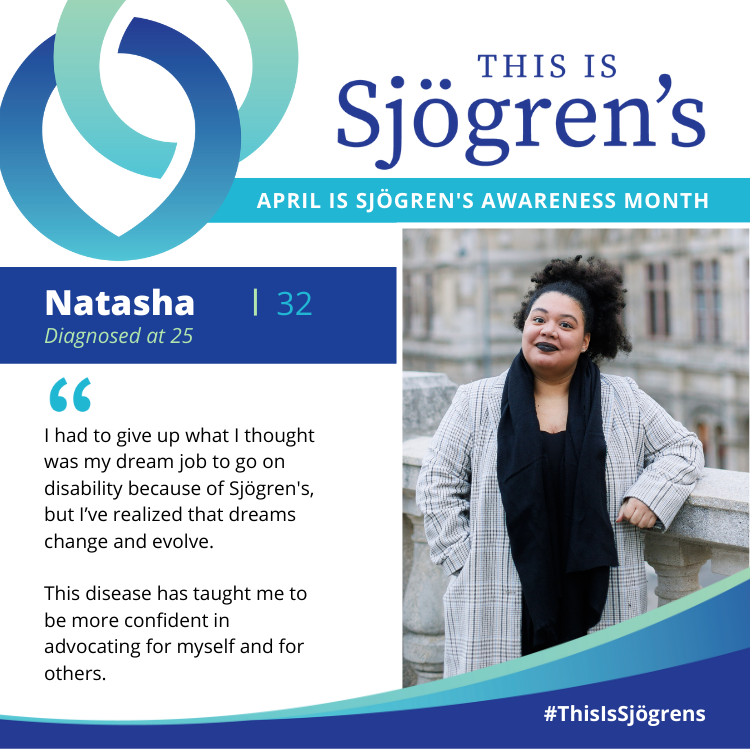
Day 1: Natasha 32 (diagnosed at 25)
I had to give up what I thought was my dream job to go on disability because of Sjögren's, but I’ve realized that dreams change and evolve.
My most difficult symptoms are total body inflammation, widespread pain and dysautonomia. This disease has taught me to be more confident in advocating for myself and for others.
Click here to learn more about Sjögren's.
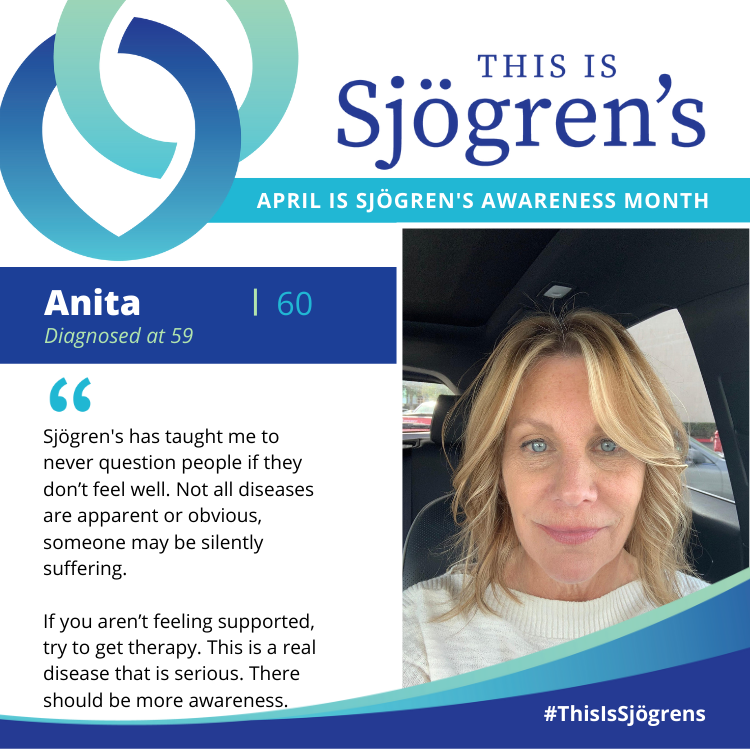
Day 2: Anita 60 (diagnosed at 59)
Sjögren's has taught me to never question people if they don’t feel well. Not all diseases are apparent or obvious, someone may be silently suffering.
If you aren’t feeling supported, try to get therapy. This is a real disease that is serious. There should be more awareness.
Click here to learn more about Sjögren’s.
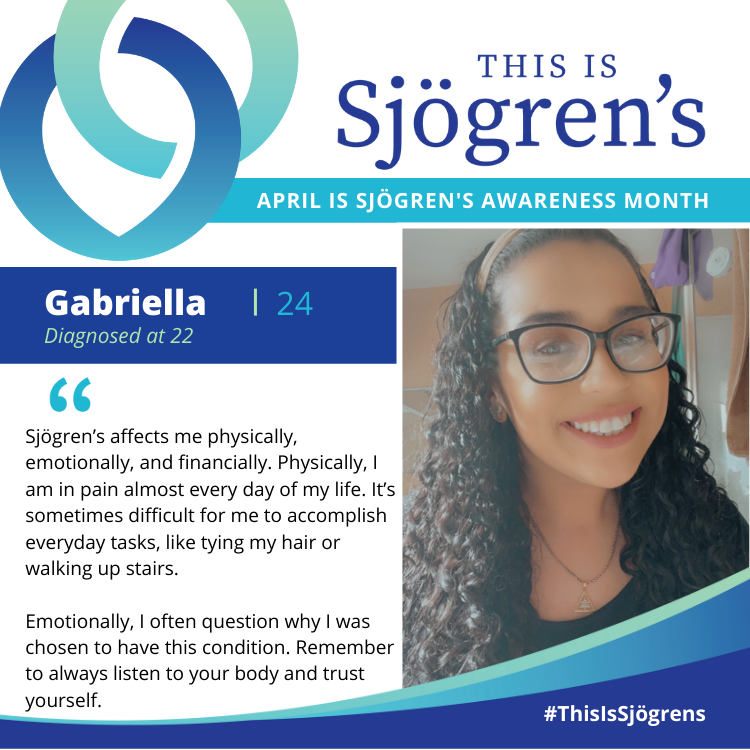
Day 3: Gabriella 24 (diagnosed at 22)
Sjögren’s affects me physically, emotionally, and financially. Physically, I am in pain almost every day of my life. It’s sometimes difficult for me to accomplish everyday tasks, like tying my hair or walking up stairs.
Emotionally, I often question why I was chosen to have this condition. And financially, well, we all know that having an autoimmune disorder is not cheap by any means with medications, doctor appointments, therapies, and more. Always listen to your body and trust yourself.
Click here to learn more about the physical and emotional burden of Sjögren’s.
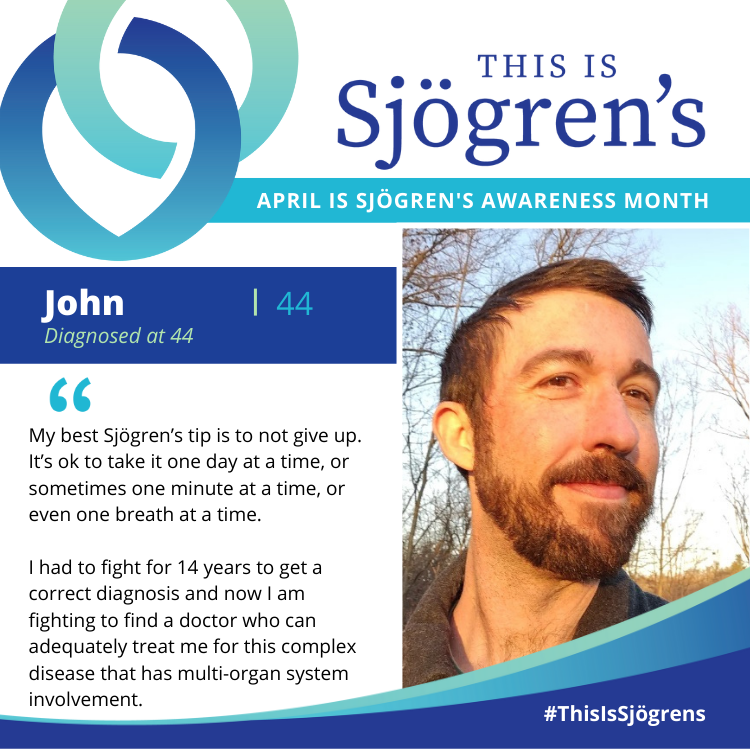
Day 4: John 44 (diagnosed at 44)
My best Sjögren’s tip is to not give up. It’s ok to take it one day at a time, or sometimes one minute at a time, or even one breath at a time.
I had to fight for 14 years to get a correct diagnosis and now I am fighting to find a doctor who can adequately treat me for this complex disease that has multi-organ system involvement.
Click here to learn more about Sjögren’s in men.
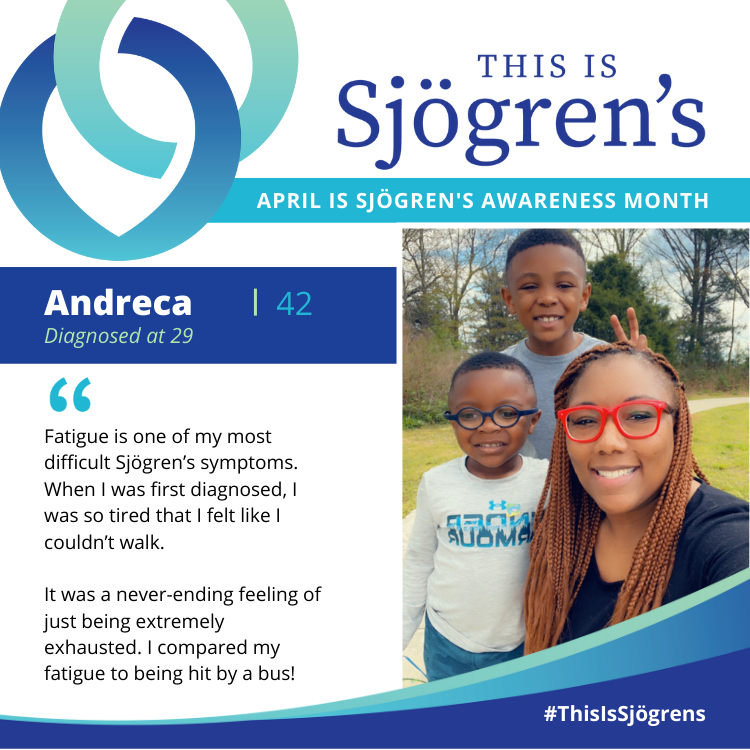
Day 5: Andreca 42 (diagnosed at 29)
Fatigue is one of my most difficult Sjögren’s symptoms. When I was first diagnosed, I was so tired that I felt like I couldn’t walk. It was a never-ending feeling of just being extremely exhausted. I compared my fatigue as being hit by a bus!
I wish I had known sooner that I could find a doctor who would take this symptom seriously.
Click here to learn more about Sjögren’s fatigue.
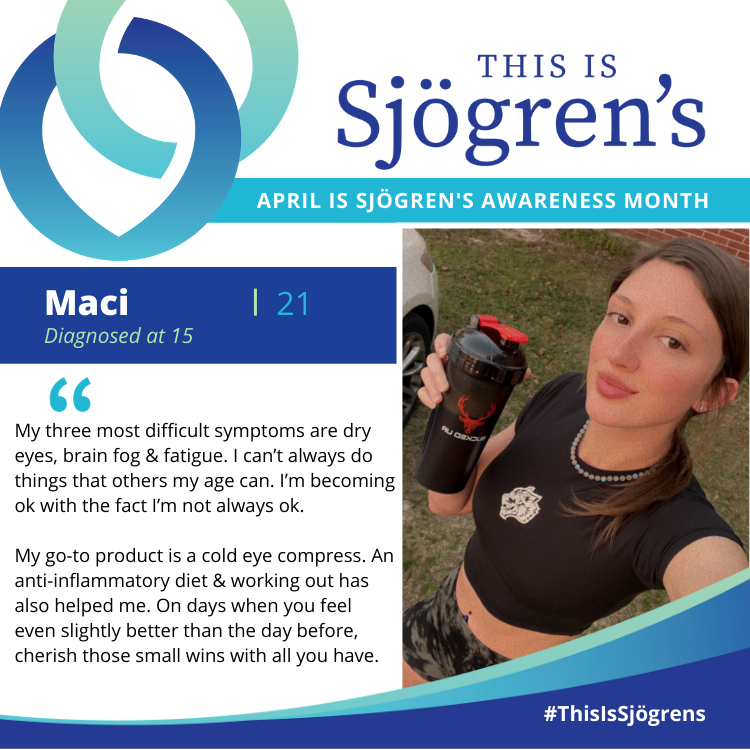
Day 6: Maci 21 (diagnosed at 15)
My three most difficult Sjögren’s symptoms are dry eyes, brain fog, fatigue. I can’t always do things that others my age can and I’m becoming ok with the fact I’m not always ok.
My go-to Sjögren’s product is a cold eye compress. An anti-inflammatory diet and working out has also helped me. Working out has not only helped with my symptoms, but it helps me mentally work through things and gives me a break for myself. On days when you feel even slightly better than the day before, cherish those small wins with all you have.Click here to learn more about the Foundation’s Patient Education Sheets, including information on an Anti-Inflammatory Diet with Sjögren’s.
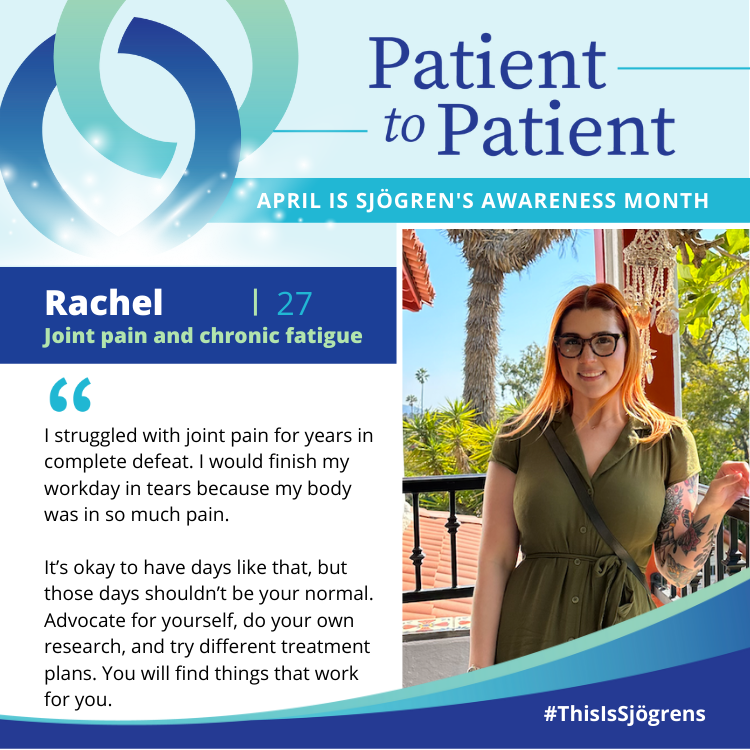
Every Friday in April the Foundation will share a Patient-to-Patient story that discuss a specific symptom or aspect of living with Sjögren’s. These stories will be continued after April for patients to share directly how they are effectively coping with the disease and offer advice for others.
Day 7: Rachel 27 (diagnosed at 25)
Patient-to-patient topic: Joint pain and chronic fatigue
I struggled with joint pain for years in complete defeat. I would finish my workday in tears because my body was in so much pain. It’s okay to have days like that, but those days shouldn’t be your normal. Advocate for yourself, do your own research and try different treatment plans.
I had no hope that I could live a somewhat normal life, sure I still have flares and bad days, but my quality of life has changed dramatically, and this was not handed to me. I fought for it. Keep the fight inside of you!
Best advice: There are solutions to symptoms. Know that there are doctors who are proactive and will want to find the right treatment plan for you. It is important try different things and don’t be discouraged if/when a medication or treatment plan doesn’t work for you. What works for some people, won’t work for everyone, but you will find things that work for you.
Go-to products/tools: Epsom salt baths, Advil Dual Action, a heating pad, and hydroxychloroquine.
Click here to learn more about chronic pain and Sjögren's.
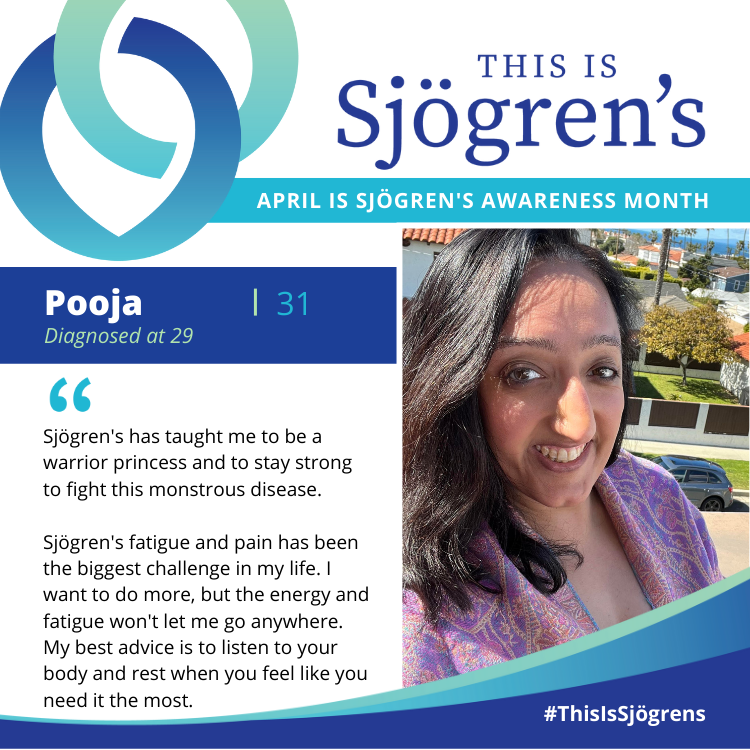
Day 8: Pooja 31 (diagnosed at 29)
Sjögren's has taught me to be a warrior princess and to stay strong to fight this monstrous disease.
Sjögren's fatigue and pain has been the biggest challenge in my life. I want to do more, but the energy and fatigue won't let me go anywhere. My best advice is to listen to your body and rest when you feel like you need it the most.
Go-to products: Using the Calm App on my phone to relax when I am not feeling well, drinking plenty of lemon water/carry my Sjögren's water bottle everywhere, and I use a heating pad to alleviate fatigue and tiredness.Click here to view the Foundation’s store to view our water bottle and more awareness items.
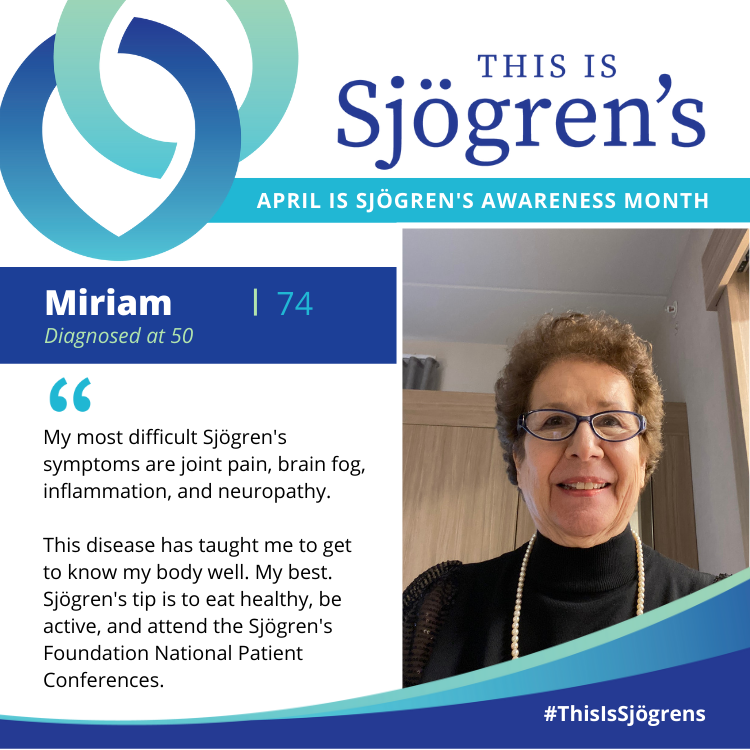
Day 9: Miriam 74 (diagnosed at 50)
My most difficult Sjögren's symptoms are joint pain, brain fog, inflammation, and neuropathy.
This disease has taught me to get to know my body well. My best Sjögren's tip is to eat healthy, be active, and attend the Sjögren's Foundation National Patient Conferences.
Click here to learn more about the upcoming Sjögren's Foundation National Patient Conference.
*A national patient conference scholarship program is available for those in need of financial assistance. Email info [at] sjogrens [dot] org (info[at]sjogrens[dot]org) for information about available scholarships.
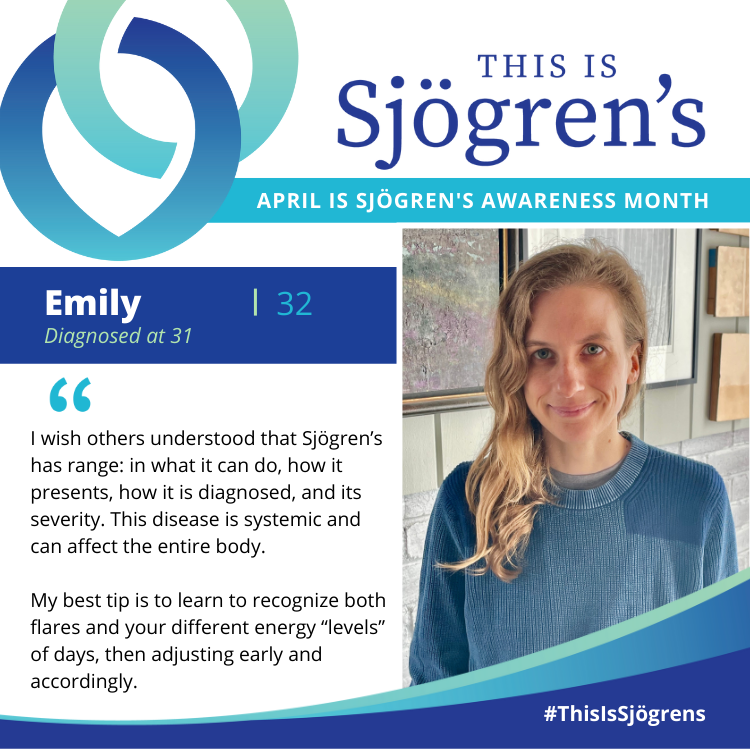
Day 10: Emily 32 (diagnosed at 31
I wish others understood that Sjögren’s has range: in what it can do, how it presents, how it is diagnosed, and its severity. This disease is systemic and can affect the entire body. My most difficult symptoms are neurological (neuropathy and dysautonomia), fatigue, dryness, and muscle pain.
My best tip is to learn to recognize both flares and your different energy “levels” of days, then adjusting early and accordingly.
Click here to learn more about Sjögren’s flares.
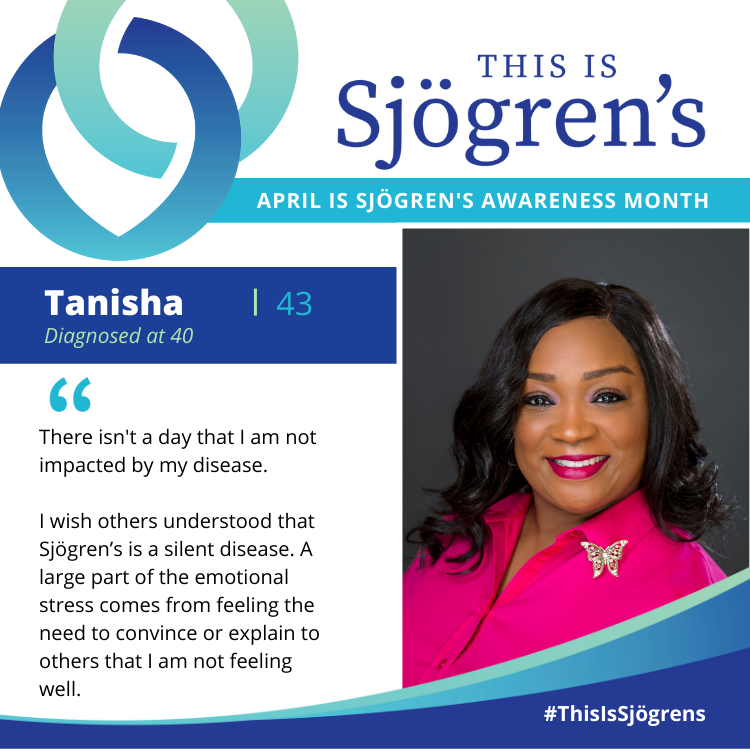
Day 11: Tanisha 43 (diagnosed at 40)
There isn't a day that I am not impacted by my disease. I wish others understood that Sjögren’s is a silent disease. A large part of the emotional stress comes from feeling the need to convince or explain to others that I am not feeling well.
I am thankful for my husband and my kids, who have taken the time to become more educated about this disease and help me. They can recognize when I’m in a disease flare and need support.Click here for Sjögren’s information for family and friends.
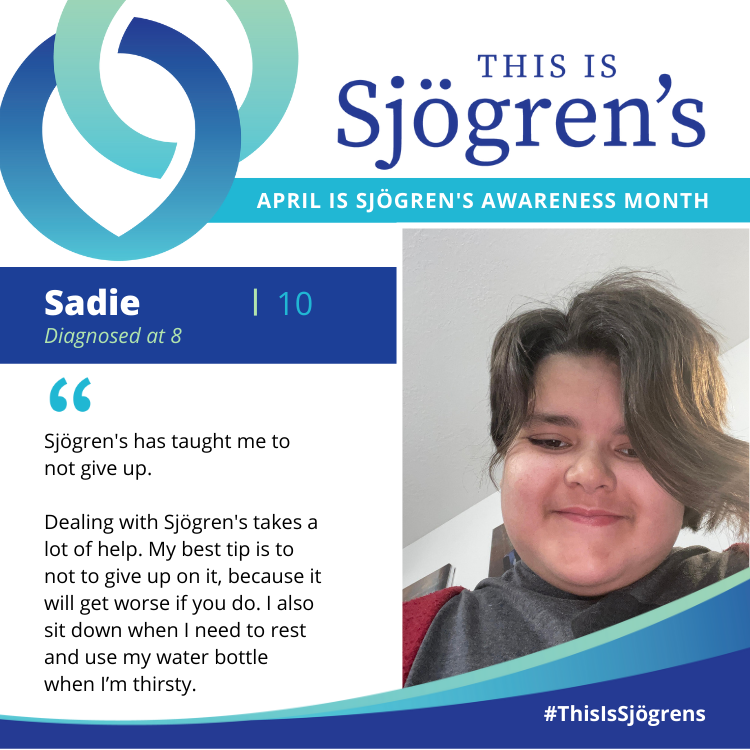
April 12 is Pediatric Sjögren’s Awareness Day
Day 12: Sadie 10 (diagnosed at 8)
Sjögren's has taught me to not give up.
Dealing with Sjögren's takes a lot of help. My best tip is to not to give up on it, because it will get worse if you do. I also sit down when I need to rest and use my water bottle when I’m thirsty.Click here to learn more about Sjögren's in children.
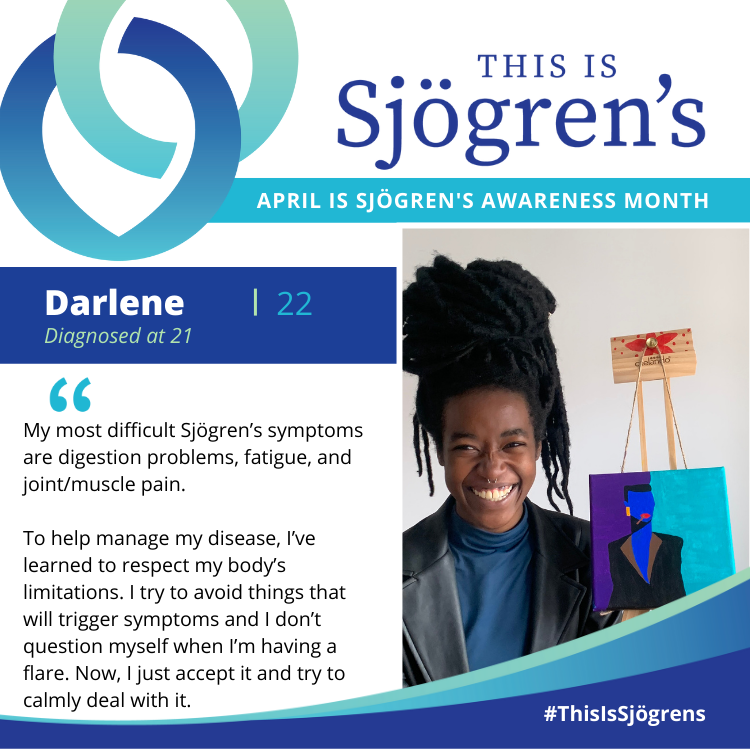
Day 13: Darlene 22 (diagnosed at 21)
My most difficult Sjögren’s symptoms are digestion problems, fatigue, and joint/muscle pain.
To help manage my disease, I’ve learned to respect my body’s limitations. I try to avoid things that will trigger symptoms and I don’t question myself when I’m having a flare. Now, I just accept it and try to calmly deal with it.
Remember to listen to your body. Take care of your physical health, without forgetting the mental health. They go hand in hand.
Click her to view tips for managing gastrointestinal symptoms in Sjögren’s.
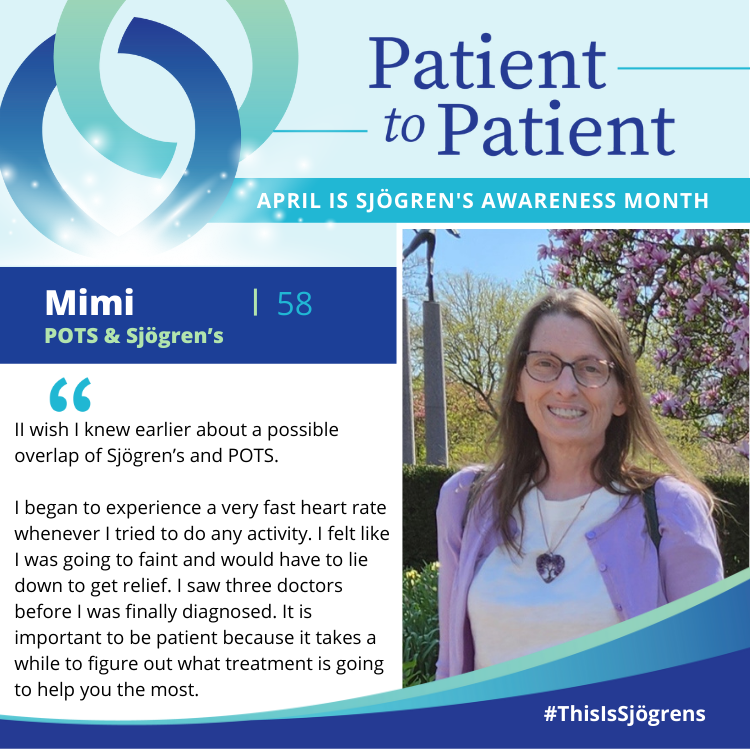
Every Friday in April the Foundation will share a Patient-to-Patient story that discuss a specific symptom or aspect of living with Sjögren’s. These stories will be continued after April for patients to share directly how they are effectively coping with the disease and offer advice for others.
Day 14: Mimi 58 (diagnosed at 47)
Patient-to-patient topic: POTS & Sjögren’s
I wish I knew earlier about a possible overlap of Sjögren’s and POTS.
I began to experience a very fast heart rate whenever I tried to do any activity. I felt like I was going to faint and would have to lie down to get relief. I saw three doctors before I was finally diagnosed. It is important to be patient because it takes a while to figure out what treatment is going to help you the most.
Most difficult Sjögren’s symptoms: Fatigue, pain, and gastrointestinal (GI) symptoms.
Best advice: Know that there are still doctors who don't know about this condition and it’s important to advocate for yourself. Prepare for your doctors' visits by writing down ahead of time what you want to discuss. Review notes again while in waiting room. Living with Sjögren’s and POTS is challenging, remember to focus on the small victories.
Go-to products/tools: A refillable water bottle, a collapsible stool that has a strap to carry it like a purse, a cooling towel for when outside in heat, following a FODmap diet, taking breaks when needed and exercising three times a week.
Click here to learn more about a new Foundation funded grant studying Sjogren’s and dysautonomia.
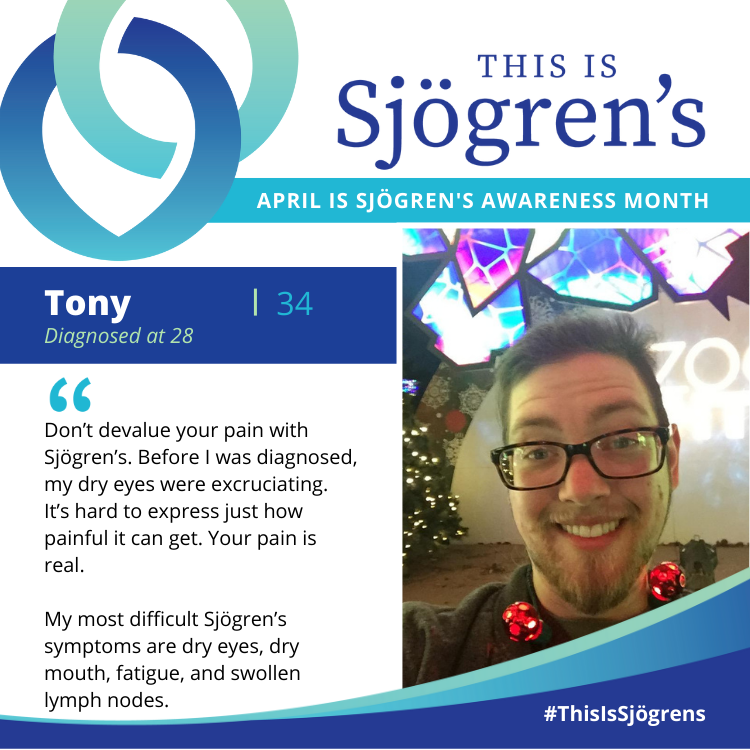
Day 15: Tony 34 (diagnosed at 28)
Don’t devalue your pain with Sjögren’s. Before I was diagnosed, my dry eyes were excruciating. It’s hard to express just how painful it can get. Your pain is real.
My most difficult Sjögren’s symptoms are dry eyes, dry mouth, fatigue, and swollen lymph nodes. Click here to learn more about Sjögren’s in men.
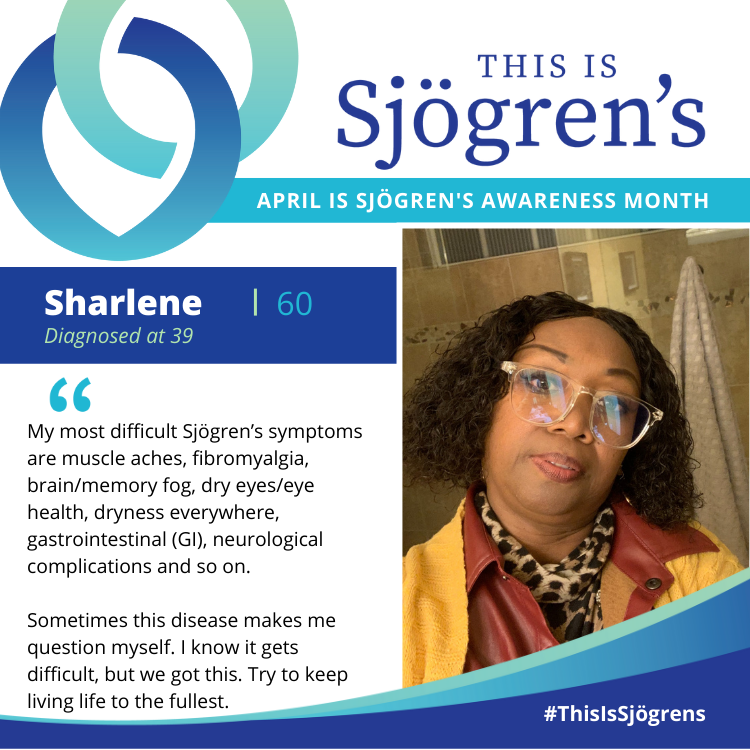
Day 16: Sharlene 60 (diagnosed at 39)
My most difficult Sjögren’s symptoms are muscle aches, fibromyalgia, brain/memory fog, dry eyes/eye health, dryness everywhere, gastrointestinal (GI), neurological and so on.
Sometimes this disease makes me question myself. I know it gets difficult, but we got this. Try to keep living life to the fullest.
Learn more about your Sjögren’s symptoms at the upcoming 2023 Virtual National Patient Conference.
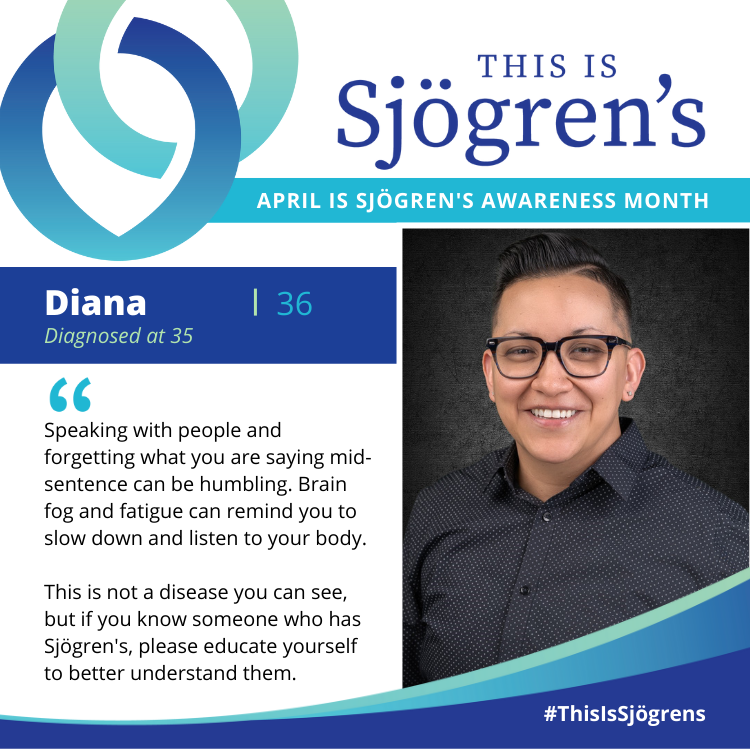
Day 17: Diana 36 (diagnosed at 35)
Speaking with people and forgetting what you are saying mid-sentence can be humbling. Brain fog and fatigue can remind you to slow down and listen to your body.
This is not a disease you can see, but if you know someone who has Sjögren's, please educate yourself to better understand them.
Click here to learn more about brain fog and Sjögren's.
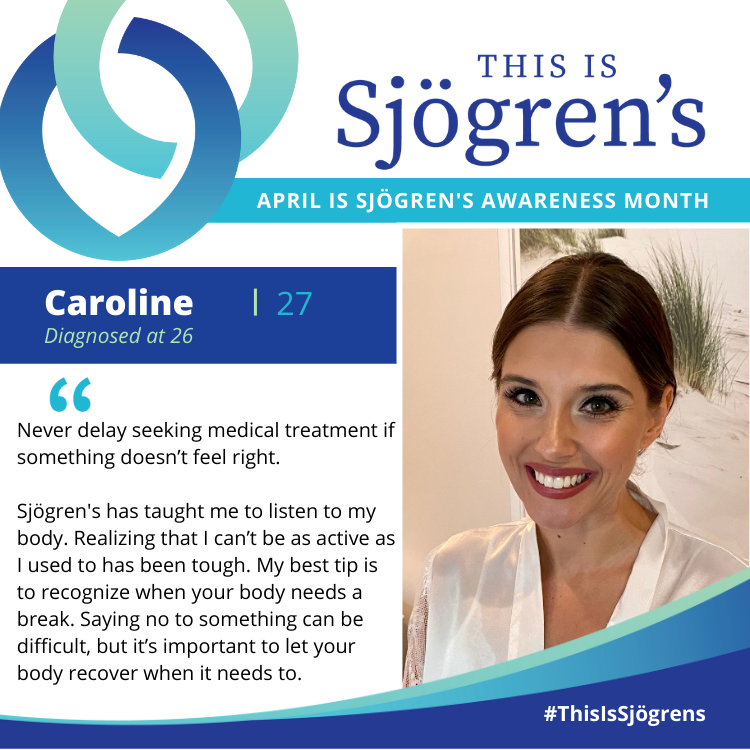
Day 18: Caroline 27 (diagnosed at 26)
Never delay seeking medical treatment if something doesn’t feel right.
Sjögren's has taught me to listen to my body. Realizing that I can’t be as active as I used to has been tough. My best tip is to recognize when your body needs a break. Saying no to something can be difficult, but it’s important to let your body recover when it needs to.
My go-to Sjögren's products/ tools are scleral contact lenses and preservative free eye drops.
Click here to learn more about scleral lenses and other dry eye options.
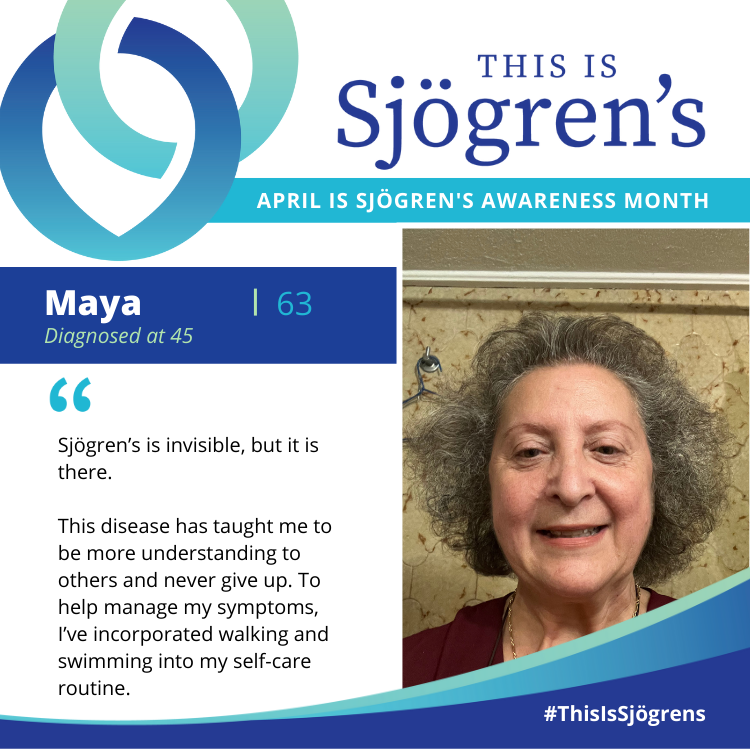
Day 19: Maya 63 (diagnosed at 45)
Sjögren’s is invisible, but it is there.
This disease has taught me to be more understanding to others and never give up. To help manage my symptoms, I’ve incorporated walking and swimming into my self-care routine.
Click here to learn more about Foundation Walk for Sjögren’s events.
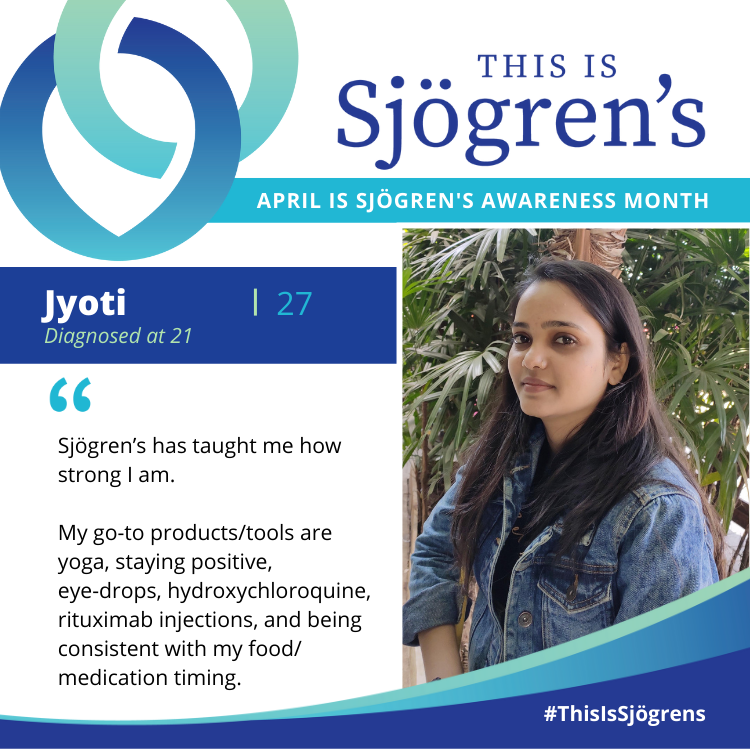
Day 20: Jyoti 27 (diagnosed at 21)
Sjögren’s has taught me how strong I am.
My go-to products/tools are yoga, staying positive, eye-drops, hydroxychloroquine, rituximab injections, and being consistent with my food/ medication timing. Learn more from our blog post, “Ask the Expert: What medications are used to treat Sjögren’s?”
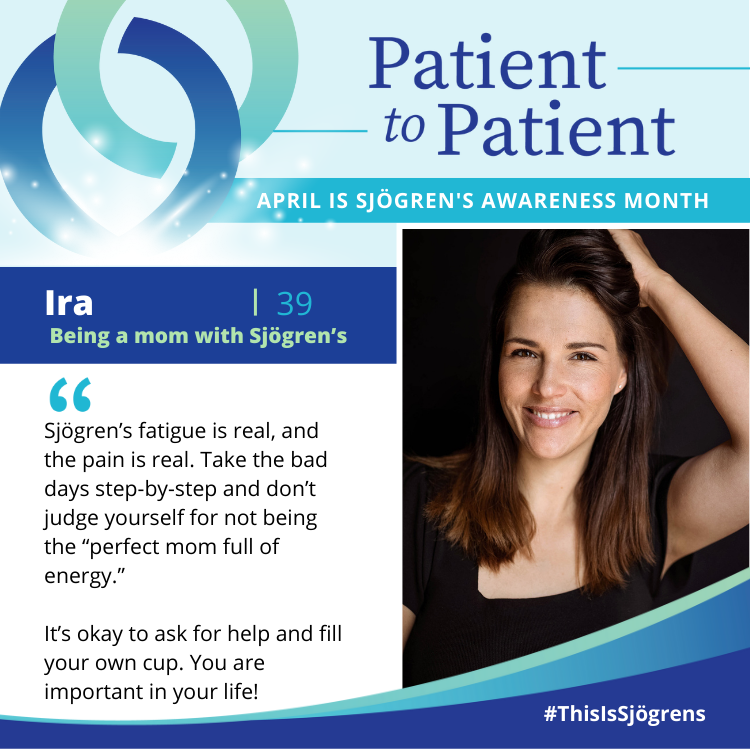
Every Friday in April the Foundation will share a Patient-to-Patient story that discuss a specific symptom or aspect of living with Sjögren’s. These stories will be continued after April for patients to share directly how they are effectively coping with the disease and offer advice for others.
Day 21: Ira 39 (diagnosed at 37)
Patient-to-patient topic: Being a mom with Sjögren’s.
Sjögren’s fatigue is real, and the pain is real. Take the bad days step-by-step and don’t judge yourself for not being the “perfect mom full of energy.”
Best advice: It’s okay to ask for help and fill your own cup. You are important in your life!
Most difficult Sjögren’s symptoms: Muscle pain, fatigue, joint pain, dry skin and feeling sick.
Go-to products/tools: Anti-inflammatory supplements and rest. #ThisIsSjögrens #PatientToPatient
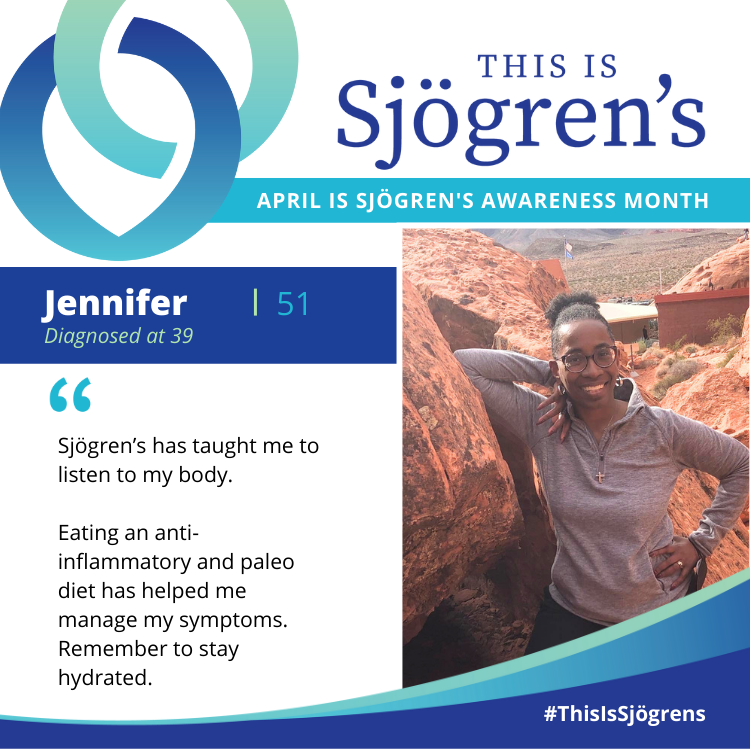
Day 22: Jennifer 51 (diagnosed at 39)
Sjögren’s has taught me to listen to my body.
Eating an anti-inflammatory diet and paleo diet has helped me manage my symptoms. Remember to stay hydrated.
Click here to view resources from the Foundation store about diet and Sjögren’s.
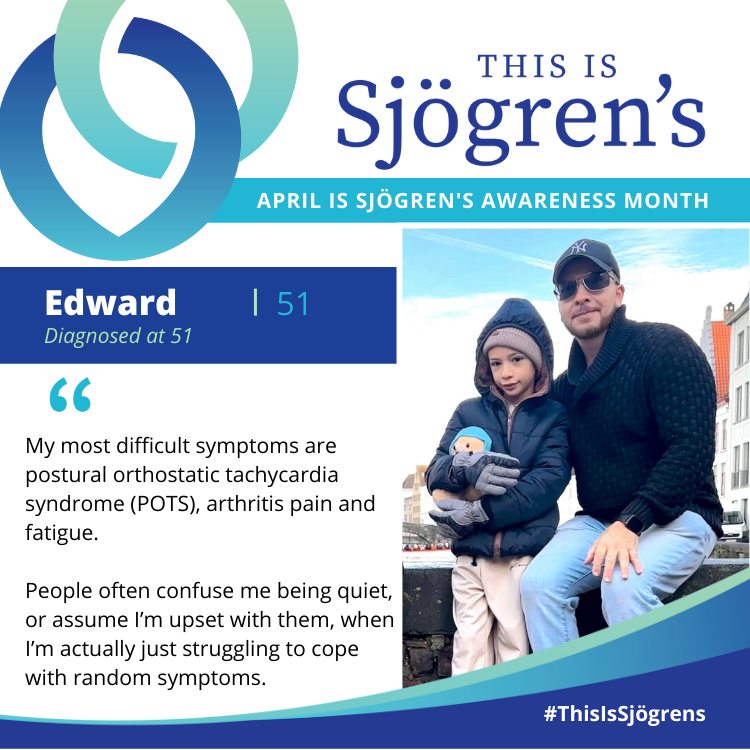
Day 23: Edward 51 (diagnosed at 51)
My most difficult symptoms are postural orthostatic tachycardia syndrome (POTS), arthritis pain and fatigue.
People often confuse me being quiet, or assume I’m upset with them, when I’m actually just struggling to cope with random symptoms. This disease has taught me acceptance and that I have to fight to stay ahead. Click here to learn more about understanding Sjögren’s.
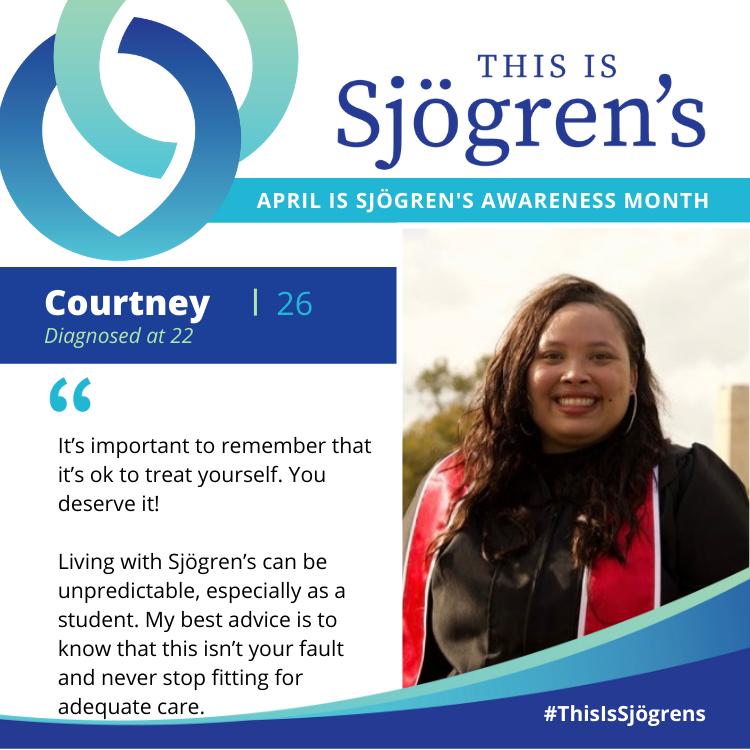
Day 24: Courtney 26 (diagnosed at 22)
It’s important to remember that it’s ok to treat yourself. You deserve it!
Living with Sjögren’s can be unpredictable, especially as a student. My best advice is to know that this isn’t your fault and never stop fitting for adequate care.
My go-to products/tools are an XXL heating pad, a handicap parking placard, Refresh Optive Mega-3 eye drops, prescription pregabalin, and CBD Epsom salt.
Click here to learn more about living with Sjögren’s.
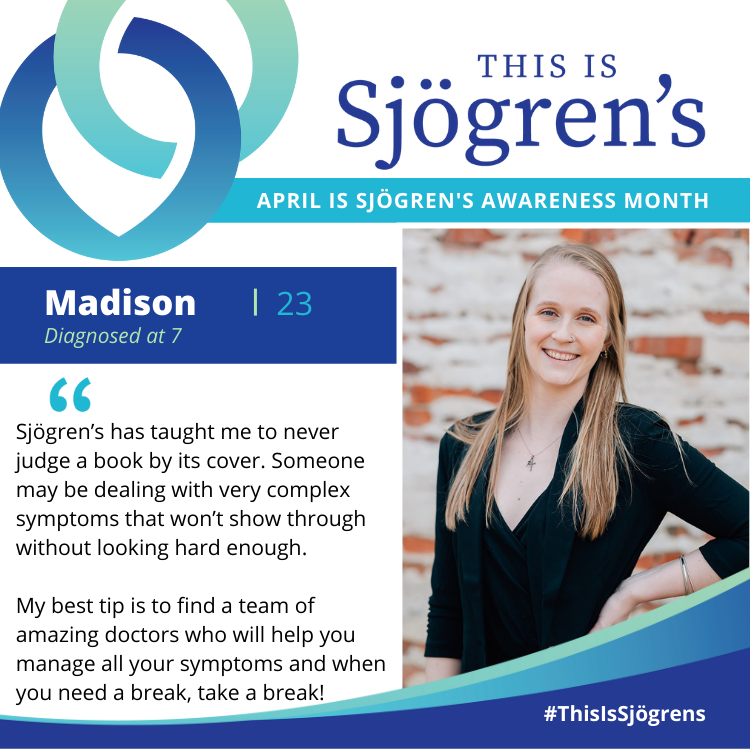
Day 25: Madison 23 (diagnosed at 7)
Sjögren’s has taught me to never judge a book by its cover. Someone may be dealing with very complex symptoms that won’t show through without looking hard enough.
My best tip is to find a team of amazing doctors who will help you manage all your symptoms and when you need a break, take a break!
Click here to learn more about living with Sjögren’s.
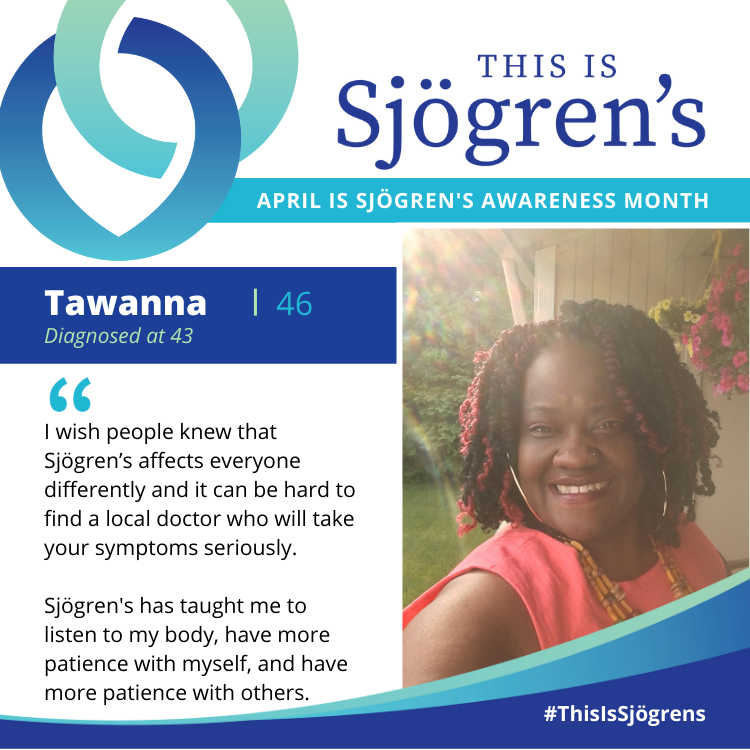
Day 26: Tawanna 46 (diagnosed at 43)
I wish people knew that Sjögren’s affects everyone differently and it can be hard to find a local doctor who will take your symptoms seriously.
Sjögren's has taught me to listen to my body, have more patience with myself, and have more patience with others.
Click here to learn more about becoming a Sjögren’s Foundation member
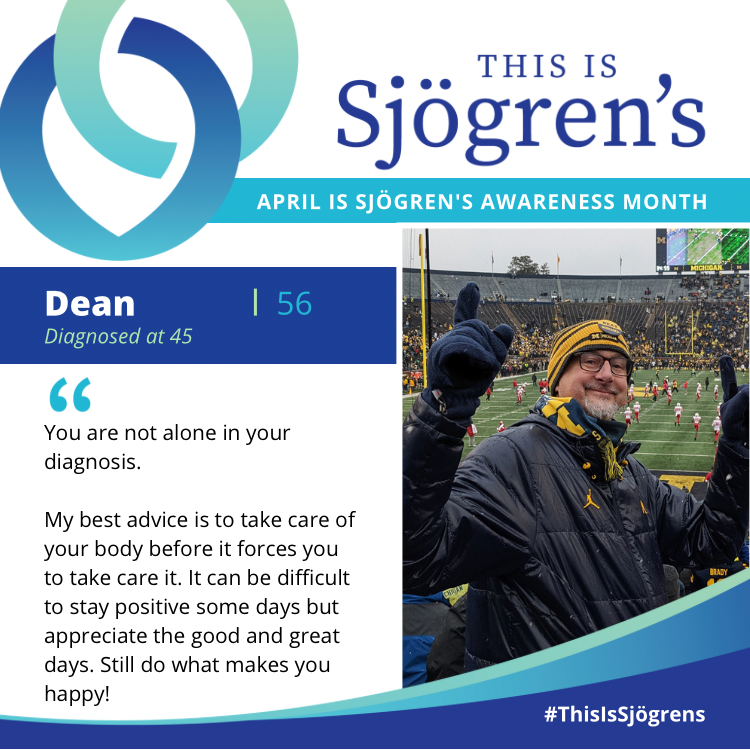
Day 27: Dean 56 (diagnosed at 45)
You are not alone in your diagnosis.
My best advice is to take care of your body before it forces you to take care it. It can be difficult to stay positive some days but appreciate the good and great days. Still do what makes you happy!Click here to learn more about becoming a Sjögren’s Foundation member
Every Friday in April the Foundation will share a Patient-to-Patient story that discuss a specific symptom or aspect of living with Sjögren’s. These stories will be continued after April for patients to share directly how they are effectively coping with the disease and offer advice for others.
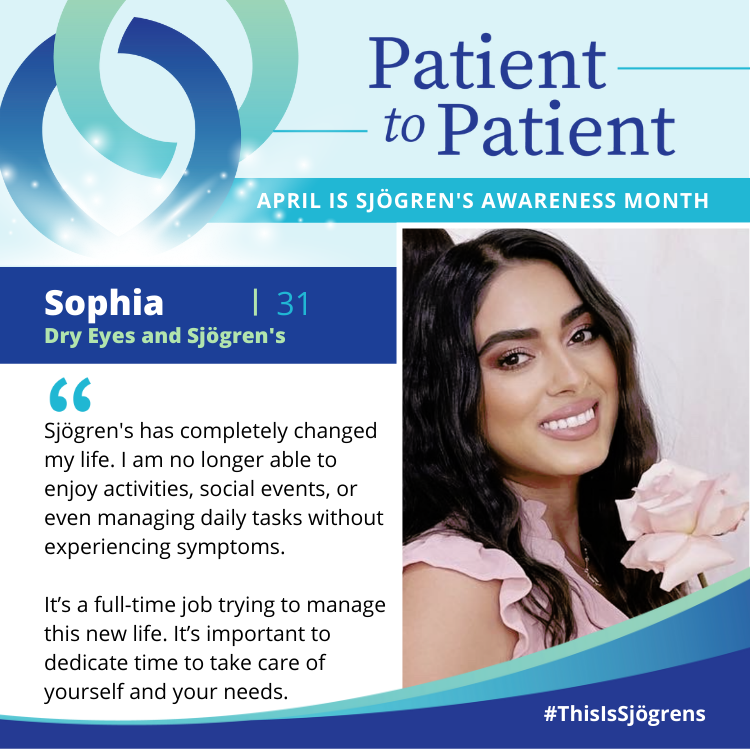
Day 28: Sophia 31 (diagnosed at 28)
Patient-to-patient topic: Dry Eyes and Sjögren’s
Sjögren’s has completely changed my life. I am no longer able to enjoy activities, social events, or even managing daily tasks without experiencing symptoms.
It’s a full-time job trying to manage this new life. It’s important to dedicate time to take care of yourself and your needs.
Most difficult Sjögren’s symptoms: Chronic dryness, joint pain, and dry eyes
Best advice: Oral care and eye exams are so important. Don’t put off your checkups! Get your eyes examined by a specialist who treats Sjögren’s patients. Sleep with an eye mask and humidifier. Avoid rubbing your eyes, and instead apply warm compresses to promote secretion from your glands. Blink often and wear sunglasses when outside.
Go-to products/tools: I use preservative free eye drops and keep them on hand when I need them. On hot days, having a little kit to keep on hand with eye drops, compresses and sunglasses is helpful.
Click here to learn more about becoming a Sjögren’s Foundation member.

Day 29: Susan 56 (diagnosed at 48)
Sjögren's has taught me to be patient with those who don’t understand when I am not feeling well. I need to explain why I am feeling anxious, sick, tired, and depressed.
Don’t feel bad if you need to quit doctors who are not listening to you. It took time for me to find the right rheumatologist.
Click here to learn more about becoming a Sjögren’s Foundation member.
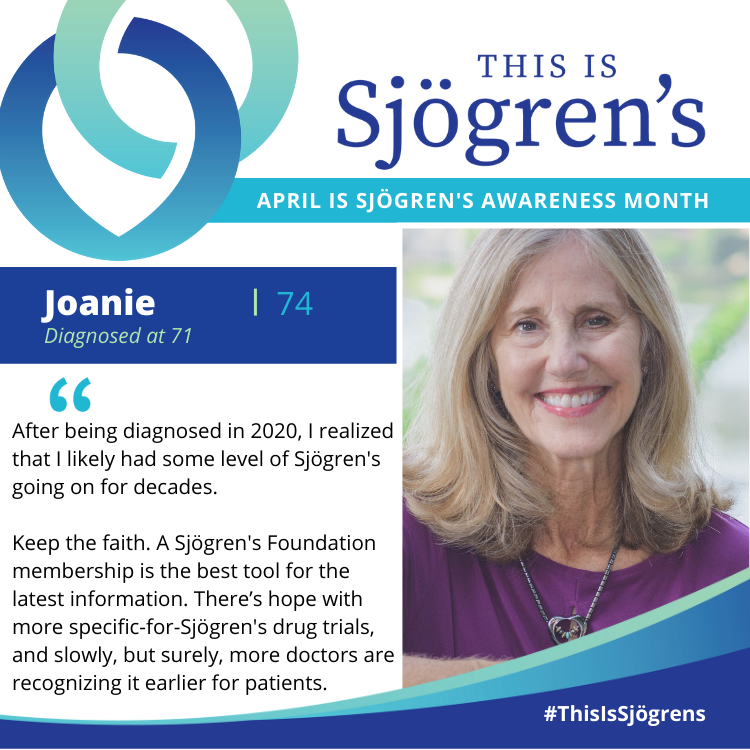
Day 30: Joanie 74 (diagnosed at 71)
After being diagnosed in 2020, I realized that I likely had some level of Sjögren's going on for decades. I suffered from irritable bowel syndrome (IBS), very dry eyes, dry skin, dry mouth, gastroesophageal reflux disease (GERD), and periodic exhaustion.
Keep the faith, help is on the way. A Sjögren's Foundation membership is the best tool for the latest information and feeling of, "You are not alone." There’s hope with more specific-for-Sjögren's drug trials, and slowly, but surely, more doctors are recognizing it earlier for patients like me. Click here to learn more about becoming a Sjögren’s Foundation member.
Thank you to everyone who shared their story and supported Sjögren’s Awareness Month. Our #ThisIsSjögrens campaign was created to highlight the many faces of Sjögren’s, because as patients, you are the voice and face of the Foundation. It is the collection of your experiences that truly portrays this complex disease and gives hopes to others by talking about ways of effectively coping with symptoms. The Foundation will continue to publish #PatientToPatient posts where you can still submit your story. Together we can reach our vision of creating a community where patients, healthcare professionals and researchers come together to conquer the complexities of Sjögren's.
*All stories come from the patient's voice. The listing of any products does not constitute as an endorsement of those products. We strongly advise that you consult with your physician, dentist and/or pharmacist regarding your treatment plan and finding what is right for you.
30 Stories for Sjögren’s Awareness
April is Sjögren’s Awareness Month! Sjögren’s is one of the most prevalent autoimmune diseases, affecting an estimated 4 million Americans. In our #ThisIsSjögrens online campaign, we are featuring 30 real patients to show the diversity and impact of this complex disease.
Every day in April, we will highlight a different patient to create a better understanding of the disease. While the daily posts will each give one small glimpse into living with Sjögren’s, by the end of April, we hope these 30 posts will help others understand that the disease is serious, systemic and prevalent. In addition, this year, we will also feature an in-depth “patient to patient” story on Fridays that look at specific disease symptoms and share how patients are effectively coping with the disease and offer advice for others.
We encourage you to follow our campaign and remember that every day is an opportunity to start a conversation about Sjögren’s and how it affects you. Together, we will conquer the complexities of Sjögren's! If you'd like to share your story, please click the link at the bottom of this page.
April is Sjögren’s Awareness Month
Sjögren’s (“SHOW-grins”) is a systemic autoimmune disease that affects the entire body. Along with symptoms of extensive dryness, other serious complications include profound fatigue, chronic pain, major organ involvement, neuropathies, and lymphomas.
Day 1: Natasha 32 (diagnosed at 25)
I had to give up what I thought was my dream job to go on disability because of Sjögren's, but I’ve realized that dreams change and evolve.
My most difficult symptoms are total body inflammation, widespread pain and dysautonomia. This disease has taught me to be more confident in advocating for myself and for others.
Click here to learn more about Sjögren's.
Day 2: Anita 60 (diagnosed at 59)
Sjögren's has taught me to never question people if they don’t feel well. Not all diseases are apparent or obvious, someone may be silently suffering.
If you aren’t feeling supported, try to get therapy. This is a real disease that is serious. There should be more awareness.
Click here to learn more about Sjögren’s.
Day 3: Gabriella 24 (diagnosed at 22)
Sjögren’s affects me physically, emotionally, and financially. Physically, I am in pain almost every day of my life. It’s sometimes difficult for me to accomplish everyday tasks, like tying my hair or walking up stairs.
Emotionally, I often question why I was chosen to have this condition. And financially, well, we all know that having an autoimmune disorder is not cheap by any means with medications, doctor appointments, therapies, and more. Always listen to your body and trust yourself.
Click here to learn more about the physical and emotional burden of Sjögren’s.
Day 4: John 44 (diagnosed at 44)
My best Sjögren’s tip is to not give up. It’s ok to take it one day at a time, or sometimes one minute at a time, or even one breath at a time.
I had to fight for 14 years to get a correct diagnosis and now I am fighting to find a doctor who can adequately treat me for this complex disease that has multi-organ system involvement.
Click here to learn more about Sjögren’s in men.
Day 5: Andreca 42 (diagnosed at 29)
Fatigue is one of my most difficult Sjögren’s symptoms. When I was first diagnosed, I was so tired that I felt like I couldn’t walk. It was a never-ending feeling of just being extremely exhausted. I compared my fatigue as being hit by a bus!
I wish I had known sooner that I could find a doctor who would take this symptom seriously.
Click here to learn more about Sjögren’s fatigue.
Day 6: Maci 21 (diagnosed at 15)
My three most difficult Sjögren’s symptoms are dry eyes, brain fog, fatigue. I can’t always do things that others my age can and I’m becoming ok with the fact I’m not always ok.
My go-to Sjögren’s product is a cold eye compress. An anti-inflammatory diet and working out has also helped me. Working out has not only helped with my symptoms, but it helps me mentally work through things and gives me a break for myself. On days when you feel even slightly better than the day before, cherish those small wins with all you have.Click here to learn more about the Foundation’s Patient Education Sheets, including information on an Anti-Inflammatory Diet with Sjögren’s.
Every Friday in April the Foundation will share a Patient-to-Patient story that discuss a specific symptom or aspect of living with Sjögren’s. These stories will be continued after April for patients to share directly how they are effectively coping with the disease and offer advice for others.
Day 7: Rachel 27 (diagnosed at 25)
Patient-to-patient topic: Joint pain and chronic fatigue
I struggled with joint pain for years in complete defeat. I would finish my workday in tears because my body was in so much pain. It’s okay to have days like that, but those days shouldn’t be your normal. Advocate for yourself, do your own research and try different treatment plans.
I had no hope that I could live a somewhat normal life, sure I still have flares and bad days, but my quality of life has changed dramatically, and this was not handed to me. I fought for it. Keep the fight inside of you!
Best advice: There are solutions to symptoms. Know that there are doctors who are proactive and will want to find the right treatment plan for you. It is important try different things and don’t be discouraged if/when a medication or treatment plan doesn’t work for you. What works for some people, won’t work for everyone, but you will find things that work for you.
Go-to products/tools: Epsom salt baths, Advil Dual Action, a heating pad, and hydroxychloroquine.
Click here to learn more about chronic pain and Sjögren's.
Day 8: Pooja 31 (diagnosed at 29)
Sjögren's has taught me to be a warrior princess and to stay strong to fight this monstrous disease.
Sjögren's fatigue and pain has been the biggest challenge in my life. I want to do more, but the energy and fatigue won't let me go anywhere. My best advice is to listen to your body and rest when you feel like you need it the most.
Go-to products: Using the Calm App on my phone to relax when I am not feeling well, drinking plenty of lemon water/carry my Sjögren's water bottle everywhere, and I use a heating pad to alleviate fatigue and tiredness.Click here to view the Foundation’s store to view our water bottle and more awareness items.
Day 9: Miriam 74 (diagnosed at 50)
My most difficult Sjögren's symptoms are joint pain, brain fog, inflammation, and neuropathy.
This disease has taught me to get to know my body well. My best Sjögren's tip is to eat healthy, be active, and attend the Sjögren's Foundation National Patient Conferences.
Click here to learn more about the upcoming Sjögren's Foundation National Patient Conference.
*A national patient conference scholarship program is available for those in need of financial assistance. Email info [at] sjogrens [dot] org (info[at]sjogrens[dot]org) for information about available scholarships.
Day 10: Emily 32 (diagnosed at 31
I wish others understood that Sjögren’s has range: in what it can do, how it presents, how it is diagnosed, and its severity. This disease is systemic and can affect the entire body. My most difficult symptoms are neurological (neuropathy and dysautonomia), fatigue, dryness, and muscle pain.
My best tip is to learn to recognize both flares and your different energy “levels” of days, then adjusting early and accordingly.
Click here to learn more about Sjögren’s flares.
Day 11: Tanisha 43 (diagnosed at 40)
There isn't a day that I am not impacted by my disease. I wish others understood that Sjögren’s is a silent disease. A large part of the emotional stress comes from feeling the need to convince or explain to others that I am not feeling well.
I am thankful for my husband and my kids, who have taken the time to become more educated about this disease and help me. They can recognize when I’m in a disease flare and need support.Click here for Sjögren’s information for family and friends.
April 12 is Pediatric Sjögren’s Awareness Day
Day 12: Sadie 10 (diagnosed at 8)
Sjögren's has taught me to not give up.
Dealing with Sjögren's takes a lot of help. My best tip is to not to give up on it, because it will get worse if you do. I also sit down when I need to rest and use my water bottle when I’m thirsty.Click here to learn more about Sjögren's in children.
Day 13: Darlene 22 (diagnosed at 21)
My most difficult Sjögren’s symptoms are digestion problems, fatigue, and joint/muscle pain.
To help manage my disease, I’ve learned to respect my body’s limitations. I try to avoid things that will trigger symptoms and I don’t question myself when I’m having a flare. Now, I just accept it and try to calmly deal with it.
Remember to listen to your body. Take care of your physical health, without forgetting the mental health. They go hand in hand.
Click her to view tips for managing gastrointestinal symptoms in Sjögren’s.
Every Friday in April the Foundation will share a Patient-to-Patient story that discuss a specific symptom or aspect of living with Sjögren’s. These stories will be continued after April for patients to share directly how they are effectively coping with the disease and offer advice for others.
Day 14: Mimi 58 (diagnosed at 47)
Patient-to-patient topic: POTS & Sjögren’s
I wish I knew earlier about a possible overlap of Sjögren’s and POTS.
I began to experience a very fast heart rate whenever I tried to do any activity. I felt like I was going to faint and would have to lie down to get relief. I saw three doctors before I was finally diagnosed. It is important to be patient because it takes a while to figure out what treatment is going to help you the most.
Most difficult Sjögren’s symptoms: Fatigue, pain, and gastrointestinal (GI) symptoms.
Best advice: Know that there are still doctors who don't know about this condition and it’s important to advocate for yourself. Prepare for your doctors' visits by writing down ahead of time what you want to discuss. Review notes again while in waiting room. Living with Sjögren’s and POTS is challenging, remember to focus on the small victories.
Go-to products/tools: A refillable water bottle, a collapsible stool that has a strap to carry it like a purse, a cooling towel for when outside in heat, following a FODmap diet, taking breaks when needed and exercising three times a week.
Click here to learn more about a new Foundation funded grant studying Sjogren’s and dysautonomia.
Day 15: Tony 34 (diagnosed at 28)
Don’t devalue your pain with Sjögren’s. Before I was diagnosed, my dry eyes were excruciating. It’s hard to express just how painful it can get. Your pain is real.
My most difficult Sjögren’s symptoms are dry eyes, dry mouth, fatigue, and swollen lymph nodes. Click here to learn more about Sjögren’s in men.
Day 16: Sharlene 60 (diagnosed at 39)
My most difficult Sjögren’s symptoms are muscle aches, fibromyalgia, brain/memory fog, dry eyes/eye health, dryness everywhere, gastrointestinal (GI), neurological and so on.
Sometimes this disease makes me question myself. I know it gets difficult, but we got this. Try to keep living life to the fullest.
Learn more about your Sjögren’s symptoms at the upcoming 2023 Virtual National Patient Conference.
Day 17: Diana 36 (diagnosed at 35)
Speaking with people and forgetting what you are saying mid-sentence can be humbling. Brain fog and fatigue can remind you to slow down and listen to your body.
This is not a disease you can see, but if you know someone who has Sjögren's, please educate yourself to better understand them.
Click here to learn more about brain fog and Sjögren's.
Day 18: Caroline 27 (diagnosed at 26)
Never delay seeking medical treatment if something doesn’t feel right.
Sjögren's has taught me to listen to my body. Realizing that I can’t be as active as I used to has been tough. My best tip is to recognize when your body needs a break. Saying no to something can be difficult, but it’s important to let your body recover when it needs to.
My go-to Sjögren's products/ tools are scleral contact lenses and preservative free eye drops.
Click here to learn more about scleral lenses and other dry eye options.
Day 19: Maya 63 (diagnosed at 45)
Sjögren’s is invisible, but it is there.
This disease has taught me to be more understanding to others and never give up. To help manage my symptoms, I’ve incorporated walking and swimming into my self-care routine.
Click here to learn more about Foundation Walk for Sjögren’s events.
Day 20: Jyoti 27 (diagnosed at 21)
Sjögren’s has taught me how strong I am.
My go-to products/tools are yoga, staying positive, eye-drops, hydroxychloroquine, rituximab injections, and being consistent with my food/ medication timing. Learn more from our blog post, “Ask the Expert: What medications are used to treat Sjögren’s?”
Every Friday in April the Foundation will share a Patient-to-Patient story that discuss a specific symptom or aspect of living with Sjögren’s. These stories will be continued after April for patients to share directly how they are effectively coping with the disease and offer advice for others.
Day 21: Ira 39 (diagnosed at 37)
Patient-to-patient topic: Being a mom with Sjögren’s.
Sjögren’s fatigue is real, and the pain is real. Take the bad days step-by-step and don’t judge yourself for not being the “perfect mom full of energy.”
Best advice: It’s okay to ask for help and fill your own cup. You are important in your life!
Most difficult Sjögren’s symptoms: Muscle pain, fatigue, joint pain, dry skin and feeling sick.
Go-to products/tools: Anti-inflammatory supplements and rest. #ThisIsSjögrens #PatientToPatient
Day 22: Jennifer 51 (diagnosed at 39)
Sjögren’s has taught me to listen to my body.
Eating an anti-inflammatory diet and paleo diet has helped me manage my symptoms. Remember to stay hydrated.
Click here to view resources from the Foundation store about diet and Sjögren’s.
Day 23: Edward 51 (diagnosed at 51)
My most difficult symptoms are postural orthostatic tachycardia syndrome (POTS), arthritis pain and fatigue.
People often confuse me being quiet, or assume I’m upset with them, when I’m actually just struggling to cope with random symptoms. This disease has taught me acceptance and that I have to fight to stay ahead. Click here to learn more about understanding Sjögren’s.
Day 24: Courtney 26 (diagnosed at 22)
It’s important to remember that it’s ok to treat yourself. You deserve it!
Living with Sjögren’s can be unpredictable, especially as a student. My best advice is to know that this isn’t your fault and never stop fitting for adequate care.
My go-to products/tools are an XXL heating pad, a handicap parking placard, Refresh Optive Mega-3 eye drops, prescription pregabalin, and CBD Epsom salt.
Click here to learn more about living with Sjögren’s.
Day 25: Madison 23 (diagnosed at 7)
Sjögren’s has taught me to never judge a book by its cover. Someone may be dealing with very complex symptoms that won’t show through without looking hard enough.
My best tip is to find a team of amazing doctors who will help you manage all your symptoms and when you need a break, take a break!
Click here to learn more about living with Sjögren’s.
Day 26: Tawanna 46 (diagnosed at 43)
I wish people knew that Sjögren’s affects everyone differently and it can be hard to find a local doctor who will take your symptoms seriously.
Sjögren's has taught me to listen to my body, have more patience with myself, and have more patience with others.
Click here to learn more about becoming a Sjögren’s Foundation member
Day 27: Dean 56 (diagnosed at 45)
You are not alone in your diagnosis.
My best advice is to take care of your body before it forces you to take care it. It can be difficult to stay positive some days but appreciate the good and great days. Still do what makes you happy!Click here to learn more about becoming a Sjögren’s Foundation member
Every Friday in April the Foundation will share a Patient-to-Patient story that discuss a specific symptom or aspect of living with Sjögren’s. These stories will be continued after April for patients to share directly how they are effectively coping with the disease and offer advice for others.
Day 28: Sophia 31 (diagnosed at 28)
Patient-to-patient topic: Dry Eyes and Sjögren’s
Sjögren’s has completely changed my life. I am no longer able to enjoy activities, social events, or even managing daily tasks without experiencing symptoms.
It’s a full-time job trying to manage this new life. It’s important to dedicate time to take care of yourself and your needs.
Most difficult Sjögren’s symptoms: Chronic dryness, joint pain, and dry eyes
Best advice: Oral care and eye exams are so important. Don’t put off your checkups! Get your eyes examined by a specialist who treats Sjögren’s patients. Sleep with an eye mask and humidifier. Avoid rubbing your eyes, and instead apply warm compresses to promote secretion from your glands. Blink often and wear sunglasses when outside.
Go-to products/tools: I use preservative free eye drops and keep them on hand when I need them. On hot days, having a little kit to keep on hand with eye drops, compresses and sunglasses is helpful.
Click here to learn more about becoming a Sjögren’s Foundation member.
Day 29: Susan 56 (diagnosed at 48)
Sjögren's has taught me to be patient with those who don’t understand when I am not feeling well. I need to explain why I am feeling anxious, sick, tired, and depressed.
Don’t feel bad if you need to quit doctors who are not listening to you. It took time for me to find the right rheumatologist.
Click here to learn more about becoming a Sjögren’s Foundation member.
Day 30: Joanie 74 (diagnosed at 71)
After being diagnosed in 2020, I realized that I likely had some level of Sjögren's going on for decades. I suffered from irritable bowel syndrome (IBS), very dry eyes, dry skin, dry mouth, gastroesophageal reflux disease (GERD), and periodic exhaustion.
Keep the faith, help is on the way. A Sjögren's Foundation membership is the best tool for the latest information and feeling of, "You are not alone." There’s hope with more specific-for-Sjögren's drug trials, and slowly, but surely, more doctors are recognizing it earlier for patients like me. Click here to learn more about becoming a Sjögren’s Foundation member.
Thank you to everyone who shared their story and supported Sjögren’s Awareness Month. Our #ThisIsSjögrens campaign was created to highlight the many faces of Sjögren’s, because as patients, you are the voice and face of the Foundation. It is the collection of your experiences that truly portrays this complex disease and gives hopes to others by talking about ways of effectively coping with symptoms. The Foundation will continue to publish #PatientToPatient posts where you can still submit your story. Together we can reach our vision of creating a community where patients, healthcare professionals and researchers come together to conquer the complexities of Sjögren's.
*All stories come from the patient's voice. The listing of any products does not constitute as an endorsement of those products. We strongly advise that you consult with your physician, dentist and/or pharmacist regarding your treatment plan and finding what is right for you.